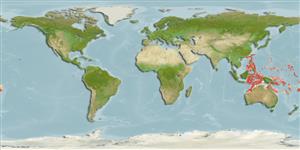Teleostei (teleosts) >
Acropomatiformes (Oceanic basses) >
Acropomatidae (Lanternbellies, temperate ocean-basses)
Etymology: Doederleinia: Ludwig Döderlein; he described sharks species/Chlamydoselachus in Tokyo bay (1879-1881) working with Garman (See under Garmanella).
Eponymy: Dr Ludwig Heinrich Philipp Döderlein (1855–1936) was a zoologist and palaeontologist. [...] (Ref. 128868), visit book page.
More on author: Hilgendorf.
Environment: milieu / climate zone / depth range / distribution range
Ecology
Marine; demersal; depth range 100 - 600 m (Ref. 76993). Tropical; 25°N - 21°S, 115°E - 177°W (Ref. 57277)
Eastern Indian Ocean to Western Pacific: NW Japan to NW Australia.
Size / Weight / Age
Maturity: Lm ? range ? - ? cm
Max length : 40.0 cm TL male/unsexed; (Ref. 637); common length : 30.0 cm TL male/unsexed; (Ref. 9137)
Feed on large crustaceans and mollusks. Utilized for human consumption (Ref. 637).
Life cycle and mating behavior
Maturity | Reproduction | Spawning | Eggs | Fecundity | Larvae
Paxton, J.R., D.F. Hoese, G.R. Allen and J.E. Hanley, 1989. Pisces. Petromyzontidae to Carangidae. Zoological Catalogue of Australia, Vol. 7. Australian Government Publishing Service, Canberra, 665 p. (Ref. 7300)
IUCN Red List Status (Ref. 130435: Version 2024-1)
Threat to humans
Harmless
Human uses
Fisheries: commercial
Tools
Special reports
Download XML
Internet sources
Estimates based on models
Preferred temperature (Ref.
123201): 11.4 - 21.3, mean 15.2 °C (based on 137 cells).
Phylogenetic diversity index (Ref.
82804): PD
50 = 1.0000 [Uniqueness, from 0.5 = low to 2.0 = high].
Bayesian length-weight: a=0.01148 (0.00705 - 0.01869), b=2.98 (2.84 - 3.12), in cm total length, based on LWR estimates for this species & (Sub)family-body (Ref.
93245).
Trophic level (Ref.
69278): 3.9 ±0.56 se; based on food items.
Generation time: 3.1 ( na - na) years. Estimated as median ln(3)/K based on 1
growth studies.
Resilience (Ref.
120179): Medium, minimum population doubling time 1.4 - 4.4 years (K=0.3).
Prior r = 0.32, 95% CL = 0.21 - 0.48, Based on 1 full stock assessment.
Fishing Vulnerability (Ref.
59153): Low to moderate vulnerability (33 of 100).
Nutrients (Ref.
124155): Calcium = 117 [73, 201] mg/100g; Iron = 1.05 [0.67, 1.62] mg/100g; Protein = 18.4 [17.5, 19.3] %; Omega3 = 0.305 [0.188, 0.495] g/100g; Selenium = 82.7 [45.2, 149.5] μg/100g; VitaminA = 20.5 [8.0, 50.2] μg/100g; Zinc = 0.99 [0.73, 1.39] mg/100g (wet weight);
